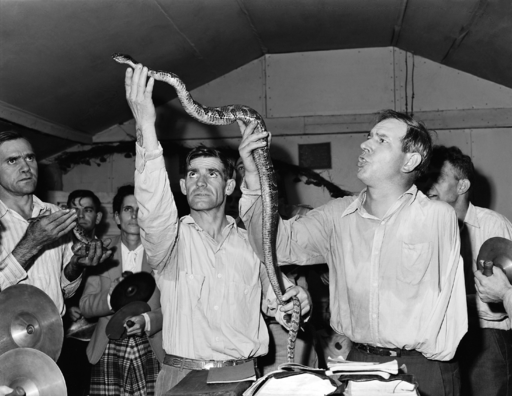
Men Handling serpents at the Pentecostal Church of God. Lejunior, Harlan County, KY, 9/15/1946 – via Wikimedia Commons (http://bit.ly/1gNhI2m)
“How many of us are willing to die for our faith?”
The question came from Bill Bisceglia, funeral director at Creech Funeral Home in Middlesboro, KY, where Jamie Coots was remembered in a service yesterday. Coots, a pastor at Full Gospel Tabernacle in Jesus’ Name in Middlesboro, Kentucky, since 1994, died Saturday as a result of a snakebite he suffered during a church service. Coots had been featured on the National Geographic Channel’s “Snake Salvation,” a reality show about pastors whose faith tradition included the handling of poisonous snakes as a means of demonstrating belief in God. Snake handling churches typically don’t belong to traditional denominations but are, instead, part of the Holiness movement.
The Holiness movement (not to be confused with the Methodist Holiness movement) is a driving ideology behind a number of Pentecostal churches, although it is important to note that not all Pentecostal churches encourage snake handling. These churches emphasize works of the Spirit as described in Acts, often pointing to miraculous healings or speaking in tongues as signs that the Holy Spirit is at work among them. They adhere to strict, literal interpretations of the Bible, greeting one another “with a holy kiss” and separating men from women during the service. Snake handling churches make up a small minority of Pentecostal churches and are concentrated mainly in Appalachia, where the practice was born in the early 20th century.
Based on passages from the New Testament books of Mark and Luke, the act of snake handling is seen as a serious rite of passage for any parishioner. Snake handlers believe these passages, in which Jesus tells his followers that miraculous signs shall follow them, are normative for the Christian community. “To me,” Coots says in the video below, “it’s much a commandment of God, when he said ‘thou shalt take up serpents,’ as it was when He said, ‘thou shalt not commit adultery.'”
http://www.youtube.com/watch?v=KMS1hULTFsE
In 1994, the same year Jamie Coots started his work as a pastor at the Full Gospel Tabernacle, Dennis Covington wrote Salvation on Sand Mountain. It is a remarkable account of the author’s journey to understand the world of snake handling and, even more improbably, to testify at services and handle a snake himself. It’s an important book to read for anyone interested in this particular Christian subculture because it not only relates how seriously parishioners take this “commandment,” but also explores how emotionally compelling the act of snake handling is. Covington wrote, “I knew then why the handlers took up serpents. There is power in the act of disappearing; there is victory in the loss of self.” Coots’ wife, Linda, says as much in the video above when she talks about the feelings of peace, calm, and happiness that come over her when she handles snakes. (My colleague Jeffrey Weiss has written about this, cautioning against labeling these beliefs “crazy.”)
Covington also looks at the notion of handling snakes as a metaphor for bringing something dark and dangerous into the light. That theory might help us to understand why snake handling is so inextricably linked to the American South, a region whose dark past can never see enough light to heal old wounds. Coots was very much a product of the South, born and raised in Middlesboro, handling snakes beginning at 23 years old. The question of snake handling in the Bible was his destiny to raise, as it had been his father’s and his father’s before him.
After Coots was bitten on Saturday, on his right hand, he went home and laid down. The paramedics left his house at 9:10 pm, after he refused treatment. He was dead an hour later.
“We missed him this morning at McDonald’s, where he always went with us,” said friend and fellow Middlesboro resident Terry Whitehed on the day of Coots’s funeral. And we return to the question Bill Bisceglia asked at the beginning. “How many of us are willing to die for our faith?”
There will always be someone willing.




